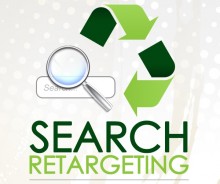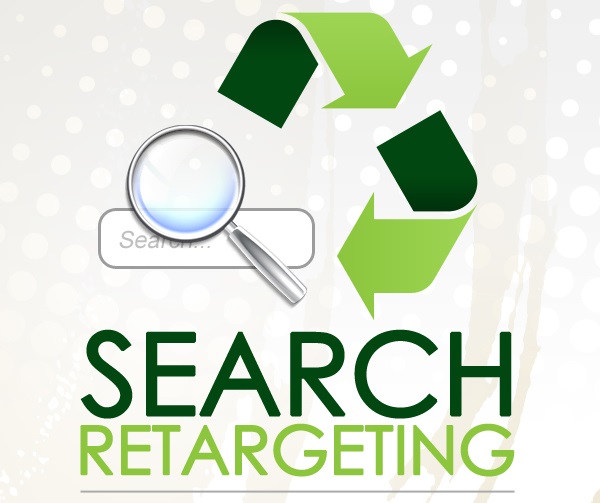Wednesday 29th July, 2015
The Insightful Media Series – Search Retargeting
In this edition of the Insightful Media Series we delve in to the topic of Search Retargeting, an underrated programmatic tool used for programmatic advertising campaigns. We will discuss how it works, why you should use it, and what the future holds. But first, we have to ask…
What is Search Retargeting?
Search retargeting is a type of behavioural retargeting that finds an audience based on cookies left by search engine queries. While standard search advertising places advertisements on the results page of search engine queries, search retargeting shows display ads to a user that has left the search results page to pursue other online activities. It usually takes the form of a standard banner ad.
How does Search Retargeting Work?
Search retargeting differs from other behavioural retargeting systems in the way that it identifies its audience. Rather than showing follow-up ads to users who have already visited an advertiser’s website, ads are shown to people who have previously searched for a specific term. They may never have come across the product before, but the affiliation between the search term and the ads served soon after helps place the message in line with their purchasing intent. This is done through Demand Side Platforms. A demand side platform (DSP) that runs search retargeting campaigns collects data from selected partners. These partners, in turn, drop cookies onto the browsers of users who arrive on their sites via search engines. THE DSPs can then use these cookies to locate and target these potential customers. The top search retargeting vendors capture billions of search terms, but some DSPs capture more than others. And the more search data you have, the more customers you’re going to be able to target .By advertising to the right person at the right time, it is an effective method of prospecting.
General Search Engines:
When a person enters a search term into a search engine there is a high chance they will miss the advertiser’s website initially, especially in a crowded market. Search retargeting helps to address this challenge. A company availing of search retargeting will initially draw up a list of their top performing keywords and keyword phrases. They would then come to a company like Insightful Media who will then create an advertising campaign and a pixel made up of these keywords and phrases. Any user who then enters in these keywords will then have a cookie attached that allows for retargeted display ads to be served to them as they surf online elsewhere. If they click on one of these ads and visit your site then you have acquired a new prospect through search retargeting.
Vertical Search Engines:
Search retargeting isn’t just limited to general search engines like Google, Bing or Yahoo. Search retargeting can be implemented on vertical search engines as well. The most valuable time to reach someone is in the initial or specific search stages, depending on how far down the purchase funnel you want to reach someone. Vertical Search Engines focus on specific segments of content based on factors such as location, topic or industry which means they can provide far more specific referrer data than general search engines. There are a number of popular examples of vertical search engines including Yelp, Hotels.com and confused.com.
Hotels and car companies are regular users of Search Retargeting. Let us imagine that when John Doe types in hotels into Google, he then finds Hotels.com in the search results. Once on the site (which acts as the vertical search engine), he then looks for hotels in Spain. From there he then looks for hotels in central Barcelona. This referrer data is then sent from Hotels.com to a third-party advertiser or DSP such as Chango or Magnetic. Barcelona advertisers, for example a car rental company, will then bid on this data from these DSP’s for the right to advertise to John Doe. John Doe will then find the winning advertisers ad on the sidebar of their search results as they continue to browse the web.
In short, these companies provide data from search cookies to Demand Side Platforms who can integrate the data to match the most relevant retargeted ads to search terms.
What are the Benefits of Search Retargeting?

The most obvious benefit to be gained from search retargeting is the ability to acquire new prospects. This is possible because users are being served an advert closely related to their recent search query. After conducting a search, users have stronger purchase intent for a product in that keyword category, and search retargeting can be used to exploit this intention to purchase.
The relevancy and recency between the search and the follow-up ad is far more likely to result in a conversion than regular display advertising.
Since search retargeting ads are served on display inventory rather than search engine inventory, pricing is not dependent on keyword competition. This makes it a very profitable solution for marketers whose choice keywords are highly competitive.
A marketer can take advantage of keyword data to provide the best CPC without the cost of keyword bidding. Also, since the ads are served as display formats, it proves beneficial for branding even if there is no purchase as a direct result of the ad.
Search retargeting also provides more visibility to users while they browse the web. Standard search marketing campaigns only place advertising in front of searchers briefly while they conduct a query as people tend to only spend about 20% of their time on search engines while online.
From a media perspective being tied into RTB media exchanges is a big advantage as it can provide access to over 90% of the population. This year, RTB-based advertising is predicted to make up 23% of digital ad sales and by 2018 it will have increased to 33%, and so search retargeting is in the middle of a strong growing phase (http://uk.businessinsider.com/the-programmatic-and-rtb-ad-report-2014-8?r=US).
The Future for Search Retargeting
In the US, search retargeting is used by 63% of brands (Econsultancy’s 2014 Display Retargetin g Buyer’s Guide). Across the pond, brands been slower on the uptake, but this is likely to change as programmatic advertising spend continues to grow.
g Buyer’s Guide). Across the pond, brands been slower on the uptake, but this is likely to change as programmatic advertising spend continues to grow.
In a bid to tap into the power of intent marketing, Rubicon purchased Chango for $122 million earlier this year (http://adexchanger.com/platforms/rubicon-project-acquires-retargeter-chango-for-122m/). Rubicon estimates that the intent marketing category will exceed $35 billion globally in 2015. With this heightened interest and investment in intent marketing, search retargeting will continue to be an important part of the savvy marketer’s digital strategy.
To discuss Search Retargeting options with Insightful Media, contact Lee on (01) 703 0406 or email lee@insightfulmedia.ie
*(Benefits of Search Retargeting Image courtesy of user Ppiboon at FreeDigitalPhotos.net)
Further Reading:
CannedBanners.com:
How Does Search Retargeting Work?
Search Engine Land:
The Highs and Lows of Search Retargeting V3.0 Is Here Already
Search Engine Land:
The Most Frequently Asked Questions in Search Retargeting
Adotas:
The Two Pronged Benefits of Search Retargeting
I Marketing Blog:
What is Search Retargeting?
Retargeter.com:
How Search Retargeting Can Solve Keyword Competition Woes
Ragan.com:
How Internet Users Worldwide Spend Time Online
MediaStreet
Search Retargeting Adoption To Accelerate Among Brands And Agencies
Why Vertical Search Is Threatening Google’s Reign
http://searchengineland.com/why-vertical-search-is-threatening-googles-reign-158434



